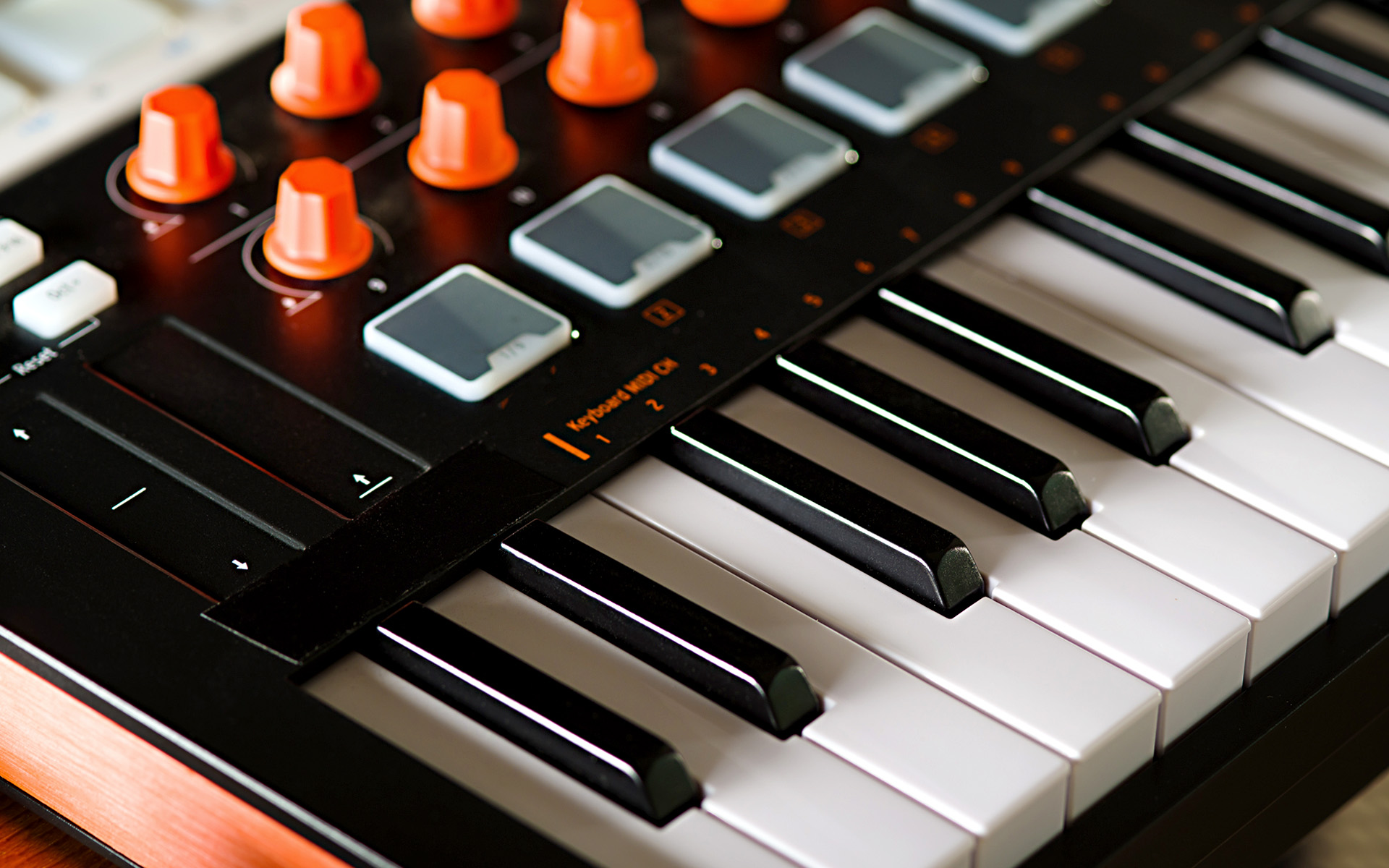9 Best MIDI Keyboards for Music Production: Expert Picks for All Levels
Choosing the right MIDI keyboard can elevate your music production game to new heights. Whether you’re a seasoned producer or a budding musician, the right MIDI keyboard can unlock endless creative possibilities and streamline your workflow. From versatile controllers to feature-packed workstations, the market offers a plethora of options to suit every need and budget.
In this article, you’ll discover the 9 best MIDI keyboards that stand out for their performance, build quality, and innovative features. We’ll break down what makes each one unique, helping you make an informed decision and find the perfect fit for your musical journey. Ready to dive in? Let’s explore the top contenders that can transform your studio setup.
Choosing the Right Midi Keyboard
Choosing the right MIDI keyboard is crucial for enhancing your music production setup.
Key Features to Look For
Connectivity. Ensure it has USB and MIDI ports for versatile connection.
Keys. Consider semi-weighted or weighted keys for a superior playing experience.
Pads. Look for velocity-sensitive drum pads for dynamic beat production.
Knobs and faders. Opt for adjustable knobs and faders to control various parameters.
Software compatibility. Check if it integrates seamlessly with your DAW (Digital Audio Workstation).
Understanding Keyboard Sizes and Octave Ranges
25-key. Compact and portable, ideal for small studio spaces.
49-key. A middle-ground option, offering more range without being too bulky.
61-key. Provides a broader range, suitable for more complex compositions.
88-key. Full-size piano range, perfect for classical and professional musicians.
Each size has its own benefits. Think about your specific needs and workspace when making a choice.
Midi Keyboard 1: The Beginner’s Best Choice
First up on our list is a MIDI keyboard perfect for beginners. It’s designed to be user-friendly while offering essential features for budding producers.
Features and Benefits
This MIDI keyboard boasts 25 velocity-sensitive keys, making it ideal for beginners who want to learn the ropes without feeling overwhelmed. It includes 8 drum pads, 8 assignable knobs, and a built-in arpeggiator, which allows you to create intricate musical patterns easily. The compact size ensures it fits comfortably in any workspace, and its USB connectivity means you can start creating right out of the box.
Pros and Cons
- Easy-to-use interface, perfect for beginners.
- Compact design, making it highly portable.
- Affordable price, great for those on a budget.
- USB powered, eliminating the need for extra cables.
- Limited to 25 keys, which may restrict more advanced play.
- Lacks advanced features found in higher-end models.
- Simplistic design might not appeal to experienced producers.
Midi Keyboard 2: The Best Budget-Friendly Option
If you’re starting or on a tight budget, don’t worry. You don’t have to break the bank to get quality gear.
Features and Benefits
This keyboard offers 25 velocity-sensitive keys, giving you expressive control over your musical performance. It also includes 8 responsive drum pads, perfect for creating beats and triggering samples. Assignable knobs let you tweak parameters, adding your unique touch to every sound. The built-in arpeggiator lets you create intricate sequences effortlessly. The USB connectivity ensures quick and easy integration with your DAW.
Pros and Cons
- Affordable: Perfect for beginners or those on a tight budget.
- Compact Design: Easy to carry and fits into small studio spaces.
- User-Friendly: Simple setup and integration with most DAWs.
- Versatile Controls: Assignable knobs and pads enhance creative flexibility.
- Limited Key Range: Only 25 keys may not suffice for complex compositions.
- Basic Features: Lacks advanced functionalities, which might limit experienced users.
Midi Keyboard 3: The Best for Professionals
When you’re ready to take your music production to the next level, a professional-grade MIDI keyboard is a must-have. Here’s what you need to know about this high-end option.
Features and Benefits
This keyboard boasts full-sized, weighted keys for an authentic piano feel. You’ll find aftertouch, which lets you impart even more expression to your playing. Connect seamlessly with DAWs and other gear via multiple MIDI ports, USB, and more, ensuring versatile compatibility. Enjoy a premium build quality that stands up to rigorous studio use. The keyboard also comes with customizable RGB backlit pads and extensive control options like sliders, knobs, and pitch/mod wheels, offering precise control over your music.
Pros and Cons
Pros:
- Full-sized, weighted keys enhance playability and realism.
- Aftertouch adds expressive capability.
- Multiple connectivity options ensure maximum compatibility.
- High-quality build lasts longer in professional environments.
- Extensive control options allow for fine-tuned music production.
Cons:
- Higher price point may be a barrier for some users.
- Larger size requires more studio space.
- Advanced features can have a steep learning curve.
When you need a MIDI keyboard that offers professional features and flexibility, Keyboard 3 stands out as a top choice in the industry.
Midi Keyboard 4: The Best for Portability
If you’re always on the go, you need a MIDI keyboard that can keep up with your busy lifestyle. Midi Keyboard 4 is perfect for musicians who prioritize portability without sacrificing essential features.
Features and Benefits
This compact device doesn’t compromise on functionality. With its lightweight design, it’s easy to carry in your backpack or gig bag. It features 25 velocity-sensitive mini keys, which provide a responsive playing experience despite their small size.
Connectivity is a breeze with its USB-MIDI interface, allowing you to quickly plug into your laptop or tablet. The keyboard also includes assignable knobs and a touch strip for pitch and modulation, enabling you to add dynamic elements to your music. Additionally, it has a built-in arpeggiator and sustain pedal input, which expand your creative options.
Pros and Cons
Pros:
- Ultra-portable: Weighs less than 2 pounds and fits easily in most bags.
- Versatile connectivity: USB-MIDI ensures compatibility with various devices.
- Assignable controls: Knobs and touch strip enhance control over your sound.
- Limited keys: 25 keys may feel restrictive for complex compositions.
- Non-weighted keys: Mini keys don’t provide the same tactile feedback as full-sized, weighted ones.
- Basic features: Lacks advanced controls which may be essential for more experienced producers.
Midi Keyboard 4 stands out as an excellent choice for those who need a portable and functional MIDI keyboard for music creation on-the-go.
Midi Keyboard 5: The Top Choice for Features
Features and Benefits
Midi Keyboard 5 stands out with its abundance of features. Boasting 61 semi-weighted keys, it gives you a perfect balance between authentic piano feel and playability. Its built-in arpeggiator and chord memory functions inspire creativity in your compositions. The keyboard also includes 16 velocity-sensitive pads for triggering samples or beats, making it a versatile tool in the studio.
It offers seamless DAW integration with customizable controls. You can map its eight assignable knobs, nine faders, and transport controls to your favorite DAW, streamlining your workflow. The MIDI output makes it compatible with other MIDI gear, broadening your setup possibilities. The LED screen provides clear navigation through settings and menus, ensuring an intuitive user experience.
Pros and Cons
- Provides 61 semi-weighted keys for enhanced playability.
- Includes 16 velocity-sensitive pads, ideal for beat-making.
- Features an arpeggiator and chord memory for creativity.
- Offers comprehensive DAW integration with assignable controls.
- LED screen facilitates easy navigation and control.
- May be more expensive than entry-level alternatives.
- Requires desk space due to its size, limiting portability.
- Advanced features might have a learning curve for beginners.
Midi Keyboard 6: The Best for Integration
When it comes to seamless integration with your digital audio workstation (DAW), Midi Keyboard 6 is a standout choice. Let’s dive into its key features and benefits to understand why it excels in this domain.
Features and Benefits
Midi Keyboard 6 includes pre-mapped controls to ensure flawless DAW integration. You’ll find 49 semi-weighted keys that offer a natural playing experience. Equipped with eight drum pads, this keyboard allows for dynamic finger drumming. It boasts nine faders and eight rotary knobs, letting you easily control virtual instruments and effects.
Seamless integration extends to its plug-and-play USB-MIDI connectivity. Midi Keyboard 6 also includes transport controls, so you can start, stop, and loop recordings without using your mouse. Bundled with industry-standard software, it simplifies your workflow right from the start.
Pros and Cons
Pros:
- Pre-mapped Controls: Quickly integrate with major DAWs like Ableton Live and Logic Pro.
- Semi-weighted Keys: Offer a responsive and tactile playing experience.
- Versatile Controls: Includes faders, rotary knobs, and drum pads for comprehensive control.
- Plug-and-Play: Easily connect via USB without extra drivers.
- Price: Higher cost may be a concern for budget-conscious users.
- Complexity: Numerous features might be overwhelming for beginners, requiring a steep learning curve.
- Portability: With extensive controls, it’s bulkier and less portable than compact models.
Midi Keyboard 6 is perfect for musicians seeking a keyboard that integrates effortlessly with their DAW, ensuring a smooth and efficient workflow.
Midi Keyboard 7: The Best for Studio Use
When designing your studio setup, choosing the best MIDI keyboard can elevate your production quality significantly.
Features and Benefits
Midi Keyboard 7 boasts an array of features geared towards professional studio environments. It includes 88 fully-weighted keys that offer authentic piano feel, ideal for expressive performance. The keyboard offers seamless DAW integration with pre-mapped controls for various popular programs like Ableton Live, Logic Pro, and Pro Tools.
- Assignable Faders and Knobs: You get 9 faders and 8 rotary knobs, providing precise control over your mixes.
- MIDI and USB Connectivity: With MIDI in/out ports and USB connectivity, you can connect multiple devices quickly.
- High-Resolution Pitch and Modulation Wheels: These enhance your ability to fine-tune your sounds with precision.
- Built-In Arpeggiator and Aftertouch: These tools inspire more creative possibilities with dynamic responses and rhythmic patterns.
Pros and Cons
-
Pros:
- Enhanced Playability: The 88 fully-weighted keys make it a dream to play for pianists and keyboardists.
- DAW Integration: Seamlessly integrates with major DAWs, streamlining your workflow.
- Extensive Controls: Assignable faders and knobs give you unrivaled control over your production settings.
- Connectivity Options: MIDI and USB offer versatile connection possibilities.
- Pricey: It’s more expensive than many entry-level models, making it an investment.
- Bulky: The size can be a drawback if you have limited studio space.
- Complexity: The extensive features might add a learning curve for beginners.
Choosing Midi Keyboard 7 for studio use is a commitment to high-quality production and expansive creative possibilities.
Midi Keyboard 8: The Best in Durability
Midi Keyboard 8 is designed for musicians who need a reliable, robust instrument for rigorous use.
Features and Benefits
Built to last, the Midi Keyboard 8 features a solid chassis and high-quality components that can withstand extensive use. It boasts 49 to 88 velocity-sensitive keys, depending on the model, with aftertouch functionality for expressive performance. The durable construction extends to the rotary knobs, sliders, and drum pads, which are all reinforced for longevity. Furthermore, seamless DAW integration ensures efficient workflow, while its MIDI and USB connectivity options facilitate versatile connections.
Pros and Cons
Pros:
- Durable Build – Offers long-term reliability with a solid chassis.
- Versatile Connectivity – MIDI and USB options for multiple setup configurations.
- Expressive Performance – Velocity-sensitive keys with aftertouch for dynamic play.
- Comprehensive DAW Integration – Streamlined control for efficient workflows.
- Heavier Weight – Solid build results in a more substantial overall weight.
- Higher Cost – Durability and quality components come at a higher price point.
- Learning Curve – Extensive features may be initially complex for novice users.
Midi Keyboard 8 stands out for its robust design and longevity, catering to musicians who demand durability in their music production tools.
Midi Keyboard 9: The Innovative Leader
Features and Benefits
Midi Keyboard 9 sets the bar high with its groundbreaking features. It includes USB-C connectivity for fast data transfer and a built-in audio interface, making it perfect for on-the-go production. The semi-weighted keys provide a realistic piano feel, while the RGB backlit pads offer customizable visual feedback. The integrated OLED screen allows for easy navigation and control without needing a computer.
Pros and Cons
- USB-C Connectivity: Ensures quick, reliable data transfer.
- Built-In Audio Interface: Great for mobile setups and reducing gear clutter.
- Semi-Weighted Keys: Delivers a realistic playing experience.
- RGB Backlit Pads: Offers customizable, responsive feedback.
- OLED Screen: Facilitates straightforward operation without external devices.
- Higher Price: Features come at a premium.
- Learning Curve: Advanced functionalities may overwhelm beginners.
- Weight: Heavier due to built-in interface and robust build.
Making the Purchase Decision
Choosing the best MIDI keyboard involves weighing various features and costs. Understand your needs to make an informed decision.
Comparing the Options
Evaluating different MIDI keyboards requires comparing key features side by side. Look at the number of keys, controller types, and connectivity options. Keyboards like Midi Keyboard 9 offer advanced features such as USB-C, semi-weighted keys, and RGB backlit pads. Contrast this with more basic models that might only provide USB connectivity and fewer control options. Make sure to consider your skill level and what functionalities you’ll actually use.
Factors to Consider Before Buying
Identify your budget. Educational MIDI keyboards can be quite affordable, while professional models can be expensive. Assess the key count; if you’re a pianist, a full 88-key model might be necessary. Analyze portability; if you’ll travel, lighter and more compact designs like portable MIDI keyboards are ideal. Consider additional features such as built-in audio interfaces or compatibility with music production software. Ensuring compatibility with your existing setup, including DAWs (Digital Audio Workstations), will smooth the integration process.
Conclusion
Choosing the right MIDI keyboard can significantly impact your music production journey. With options ranging from beginner-friendly models to advanced, professional-grade keyboards, it’s crucial to assess your needs and skill level. Consider key features like connectivity, key count, portability, and additional functionalities to make an informed decision. Whether you’re just starting out or looking to upgrade, there’s a MIDI keyboard out there that fits your requirements and budget. Happy music-making!






